weight CHEVROLET CAVALIER 1993 1.G Owners Manual
[x] Cancel search | Manufacturer: CHEVROLET, Model Year: 1993, Model line: CAVALIER, Model: CHEVROLET CAVALIER 1993 1.GPages: 308, PDF Size: 15.62 MB
Page 19 of 308
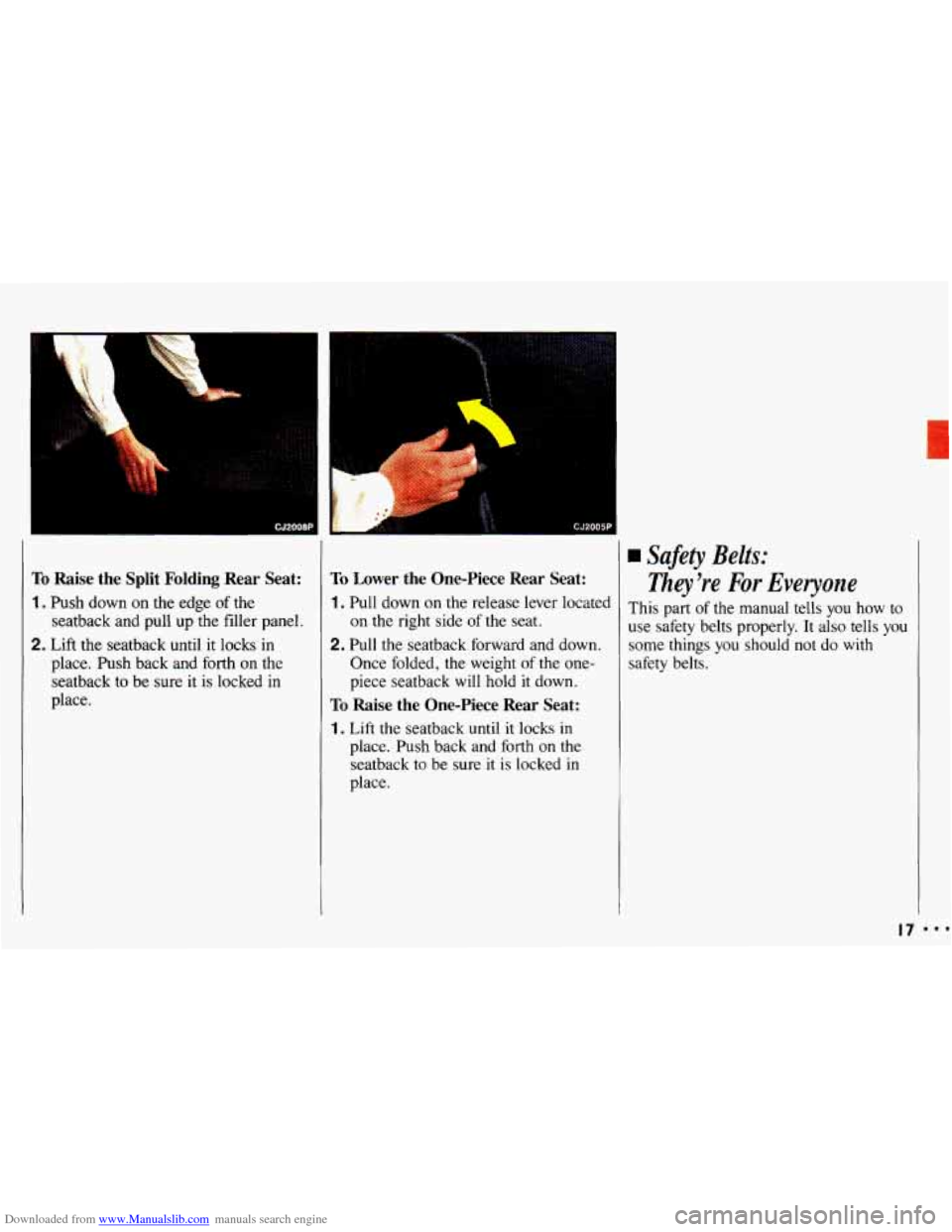
Downloaded from www.Manualslib.com manuals search engine 4
To Raise the Split Folding Rear Seat:
1. Push down on the edge of the
seatback and pull up
the filler panel.
2. Lift the seatback until it locks in
place. Push back and forth on the
seatback to be sure
it is locked in
place.
To Lower the One-Piece Rear Seat:
1. Pull down on the release lever located
on the right side
of the seat.
2. Pull the seatback forward and down.
Once folded, the weight of the one-
piece seatback
will hold it down.
To Raise the One-Piece Rear Seat:
1. Lift the seatback until it locks in
place. Push back and forth on the seatback to be sure
it is locked in
place.
Safety Belts:
They're For Everyone
This part of the manual tells you how to
use safety belts properly.
It also tells you
some things you should not do
with
safety belts.
17 ...
Page 131 of 308
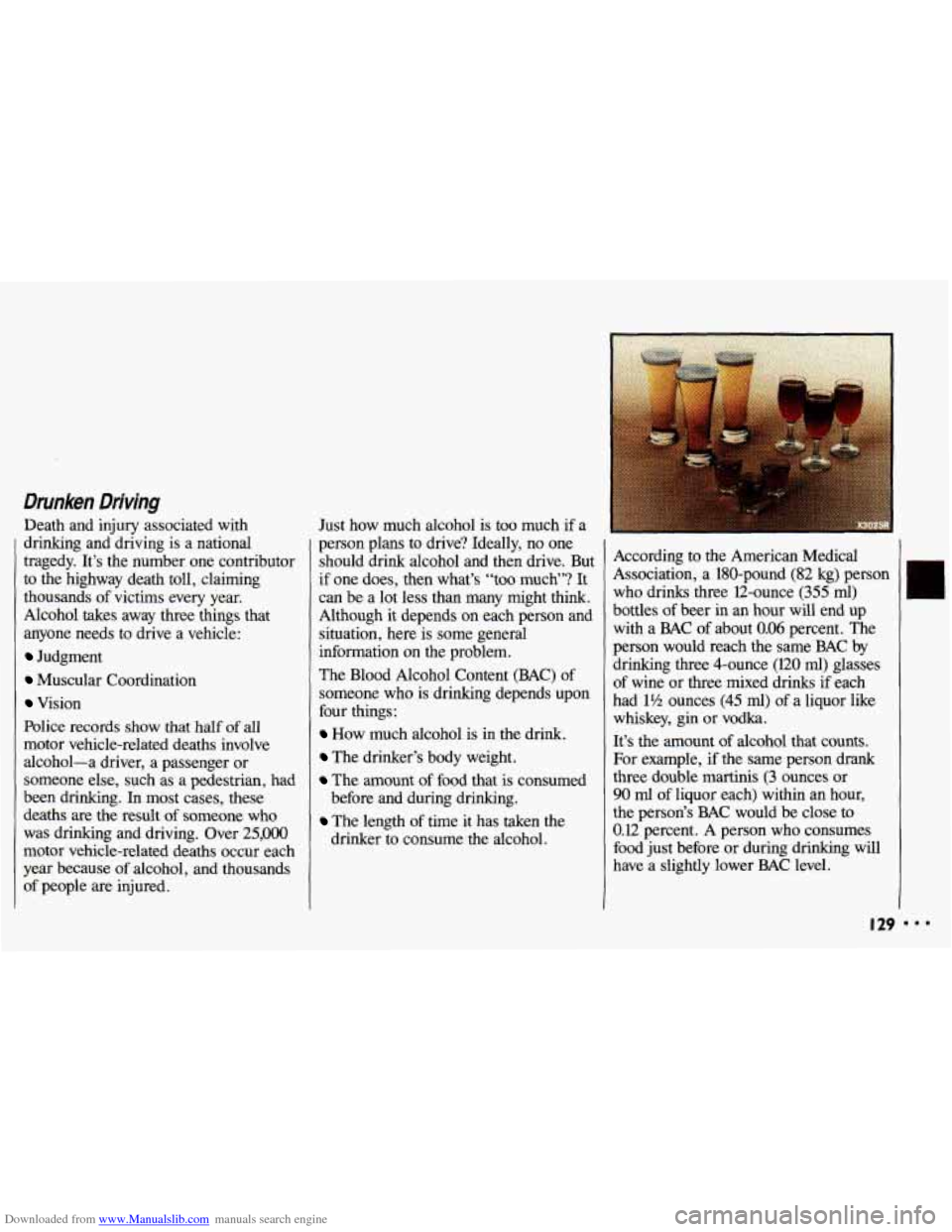
Downloaded from www.Manualslib.com manuals search engine Drunken Driving
Death and injury associated with
drinking and driving
is a national
tragedy. It’s the number one contributor
to the highway death toll, claiming
thousands of victims every year.
Alcohol takes
away three things that
anyone needs to drive a vehicle:
Judgment
Muscular Coordination
Vision
Police records
show that half of all
motor vehicle-related deaths involve alcohol-a driver, a passenger or
someone else, such as
a pedestrian, had
been drinking. In most cases, these
deaths are
the result of someone who
was drinking and driving. Over 25,000
motor vehicle-related deaths occur each
year because
of alcohol, and thousands
of people are injured. Just
how much alcohol
is too much if a
person plans to drive? Ideally, no one
should
drink alcohol and then drive. But
if one does, then what’s “too much”? It
can be a lot
less than many might think.
Although it depends on each person and
situation, here is
some general
information
on the problem,
The Blood Alcohol Content
(BAC) of
someone who is drinking depends upon
four
things:
How much alcohol is in the drink.
The drinker’s body weight.
The amount of food that is consumed
before and during
drinking.
The length of time it has taken the
drinker to consume the alcohol. According to
the American Medical
Association,
a 180-pound (82 kg) person
who drinks three E-ounce
(355 ml)
bottles of beer in an hour will end up
with a BAC of about 0.06 percent. The
person would reach the same BAC by
drinking three 4-ounce (120 ml) glasses
of wine or three mixed drinks if each
had
1% ounces (45 ml) of a liquor like
whiskey, gin or vodka.
It’s the amount of alcohol that counts,
For example, if the same person drank
three double martinis (3 ounces or
90 ml of liquor each) within an hour,
the person’s
BAC would be close to
0.12 percent. A person who consumes
food just before or during drinking will
have
a slightly lower BAC level.
I29 I..
Page 159 of 308
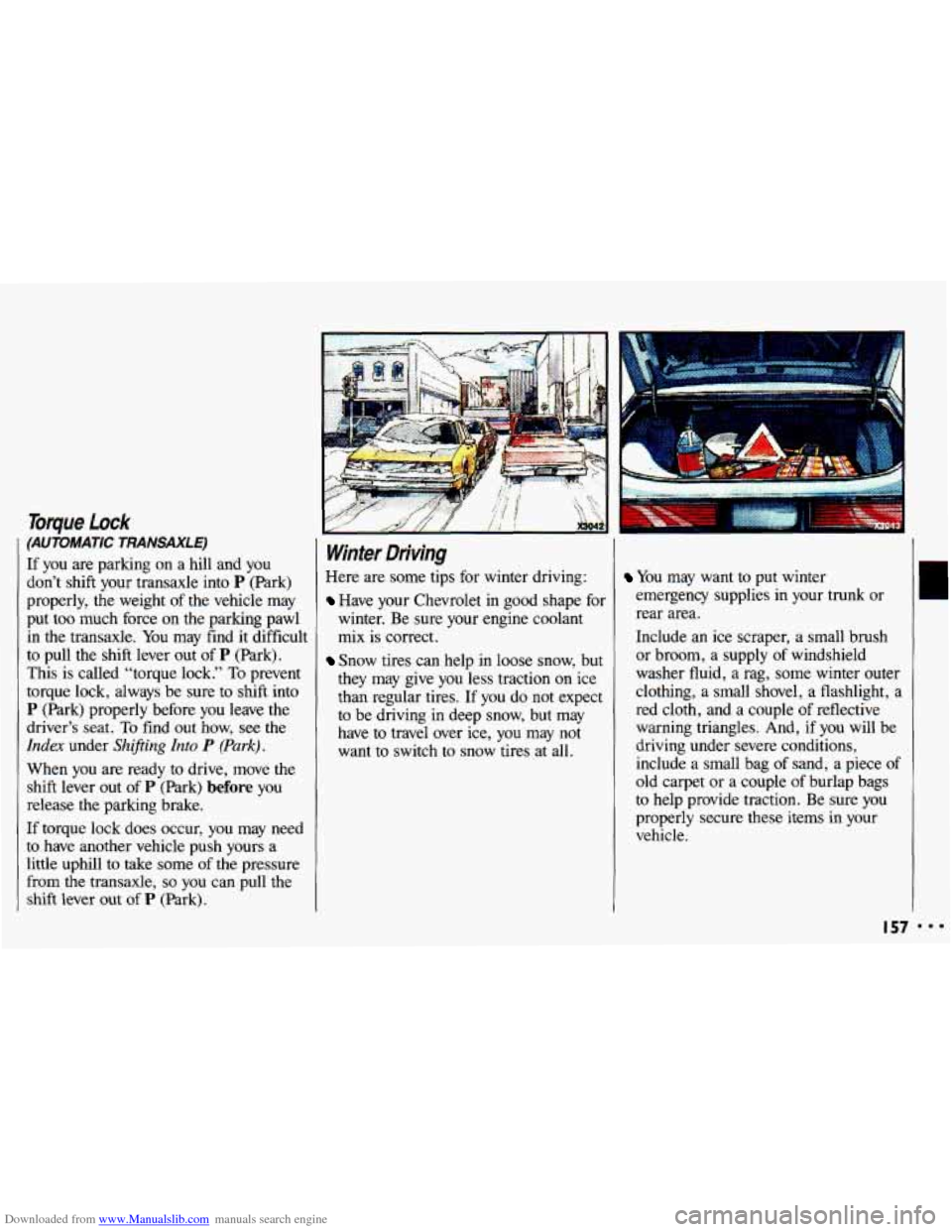
Downloaded from www.Manualslib.com manuals search engine Torque Lock
(AUTOMATIC TRANSAXLE)
If you are parking on a hill and you
don’t shift
your transaxle into P (Park)
properly, the weight of the vehicle may
put too much force on the parking pawl
in the transaxle. You may find it difficult
to pull the
shift lever out of P (Park).
This
is called “torque lock.” To prevent
torque lock, always be sure to shift into
P (Park) properly before you leave the
driver’s seat.
To find out how, see the
Index under Shiftirtg Into P (Park),
When you are ready to drive, move the
shift lever out
of P (Park) before you
release the parking brake.
If torque lock does occur, you may need
to have another vehicle push yours a
little uphill to take some
of the pressure
from the transaxle,
so you can pull the
shift lever out
of P (Park).
Winter Driving
Here are some tips for winter driving:
Have your Chevrolet in good shape for
winter. Be sure your engine coolant
mix is correct.
Snow tires can help in loose snow, but
they may give you less traction on ice
than regular tires.
If you do not expect
to be driving in deep snow, but may
have to travel over ice,
you may not
want to switch to snow tires at all.
You may want to put winter
emergency supplies in your trunk or
rear area.
Include an ice scraper, a small brush
or broom, a supply of windshield
washer fluid, a rag, some winter outer
clothing, a small shovel, a flashlight,
a
red cloth, and a couple of reflective
warning triangles. And, if you will be
driving under severe conditions,
include a small bag
of sand, a piece of
old carpet or a couple
of burlap bags
to help provide traction. Be sure you
properly secure these items
in your
vehicle.
I57
Page 229 of 308
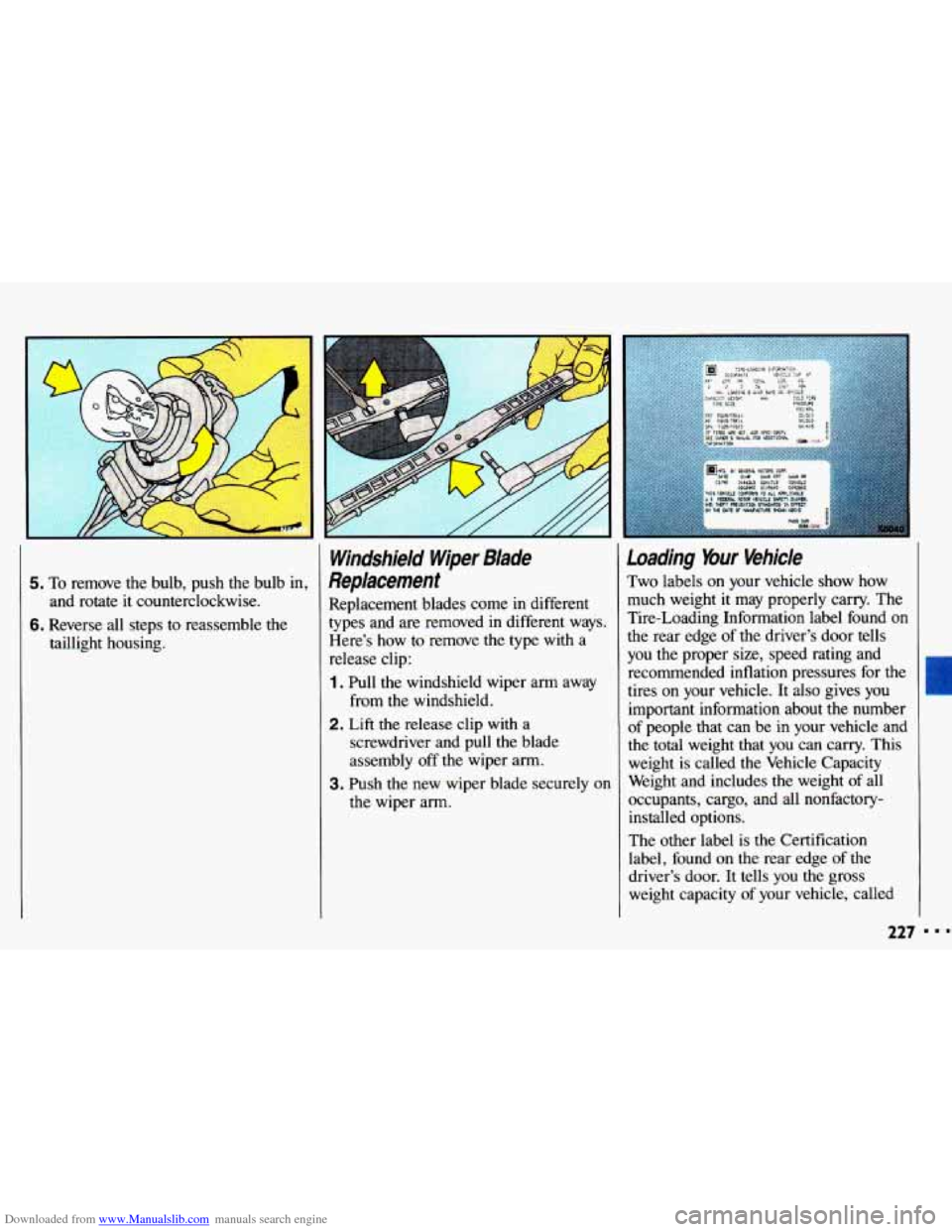
Downloaded from www.Manualslib.com manuals search engine 5. To remove the bulb, push the bulb in,
and rotate it counterclockwise.
6. Reverse all steps to reassemble the
taillight housing.
Windshield Wiper Blade
Replacement
Replacement blades come in different
types and are removed in different ways.
Here’s how
to remove the type with a
release clip:
1. Pull the windshield wiper arm away
2. Lift the release clip with a
from the windshield.
screwdriver and pull the blade
assembly
off the wiper arm.
the wiper arm.
3. Push the new wiper blade securely on
Loading %ur Vehicle
Two labels on your vehicle show how
much weight it may properly carry. The
Tire-Loading Information label found
on
the rear edge of the driver’s door tells
you the proper size, speed rating and
recommended inflation pressures for the
tires on your vehicle. It also gives
you
important information about the number
of people
that can be in your vehicle and
the total weight that you can carry. This
weight
is called the Vehicle Capacity
Weight and includes the weight
of all
occupants, cargo, and all nonfactory- installed options.
The other label
is the Certification
label, found on the rear edge of the
driver’s door. It tells you the gross
weight capacity
of your vehicle, called
I
227
Page 230 of 308
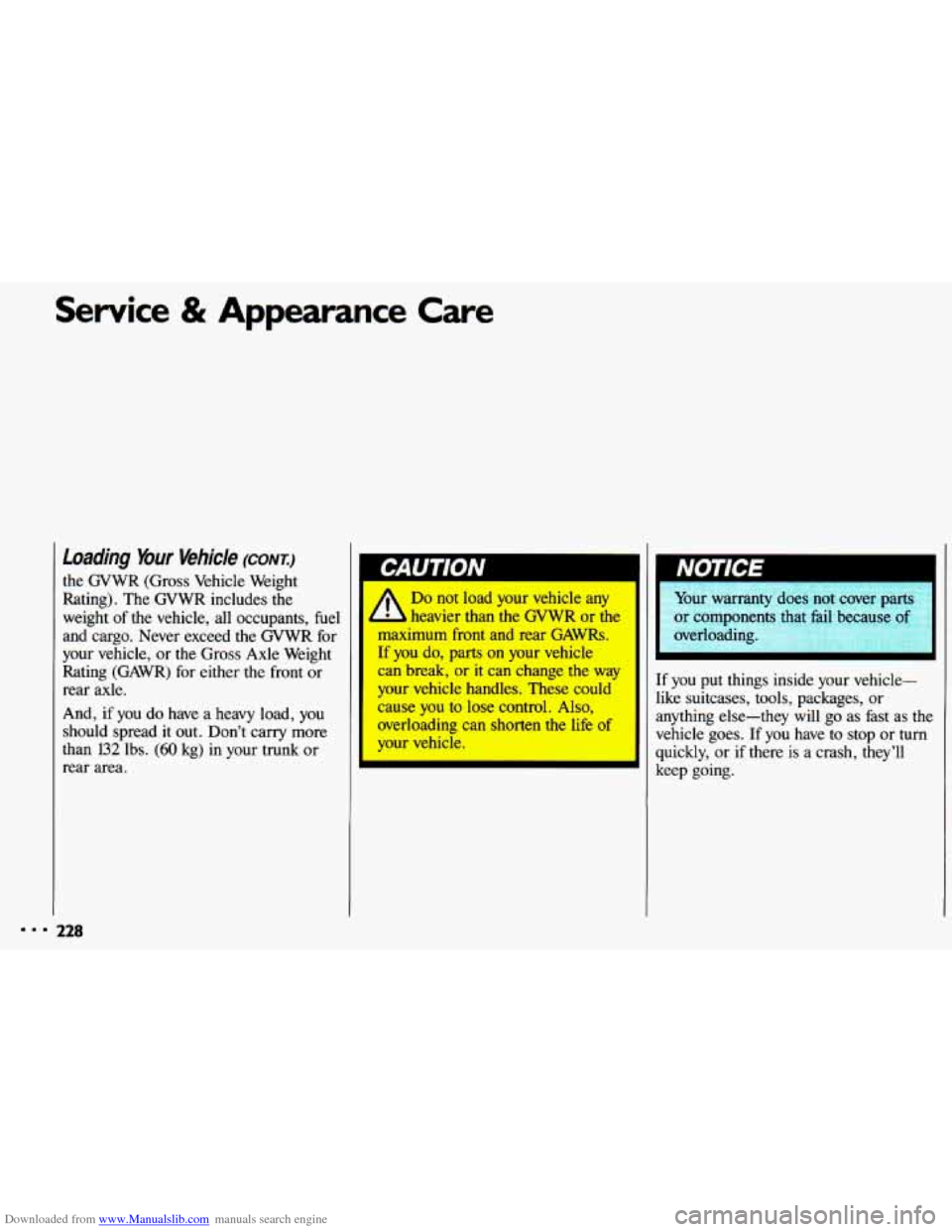
Downloaded from www.Manualslib.com manuals search engine Service & Appearance Care
Loading Your Vehicle (CONI:)
the GVWR (Gross Vehicle Weight
Rating). The GVWR includes the
weight of the vehicle, all occupants, fuel
and cargo. Never exceed the GVWR for
your vehicle, or the Gross Axle Weight
Rating (GAWR) for either the front or
rear axle.
And,
if you do have a heavy load, you
should spread
it out. Don’t carry more
than
132 lbs. (60 kg) in your trunk or
rear area.
128
Do not load your vehicle any
L b heavier than the GVWR or the
maximum front and rear GAWRs.
If
you do, parts on your vehicle
can break, or
it can change the way
your vehicle handles. These could
cause you to lose control. Also,
overloading can shorten the life of
your vehicle. Your
warranty does not cover part
or components that fail beca
: ol
overloading.
If you put things inside your vehicle-
like suitcases, tools, packages, or
anything else-they
will go as fast as the
vehicle goes. If you have to stop or turn
quickly, or
if there is a crash, they’ll
keep going.
Page 231 of 308
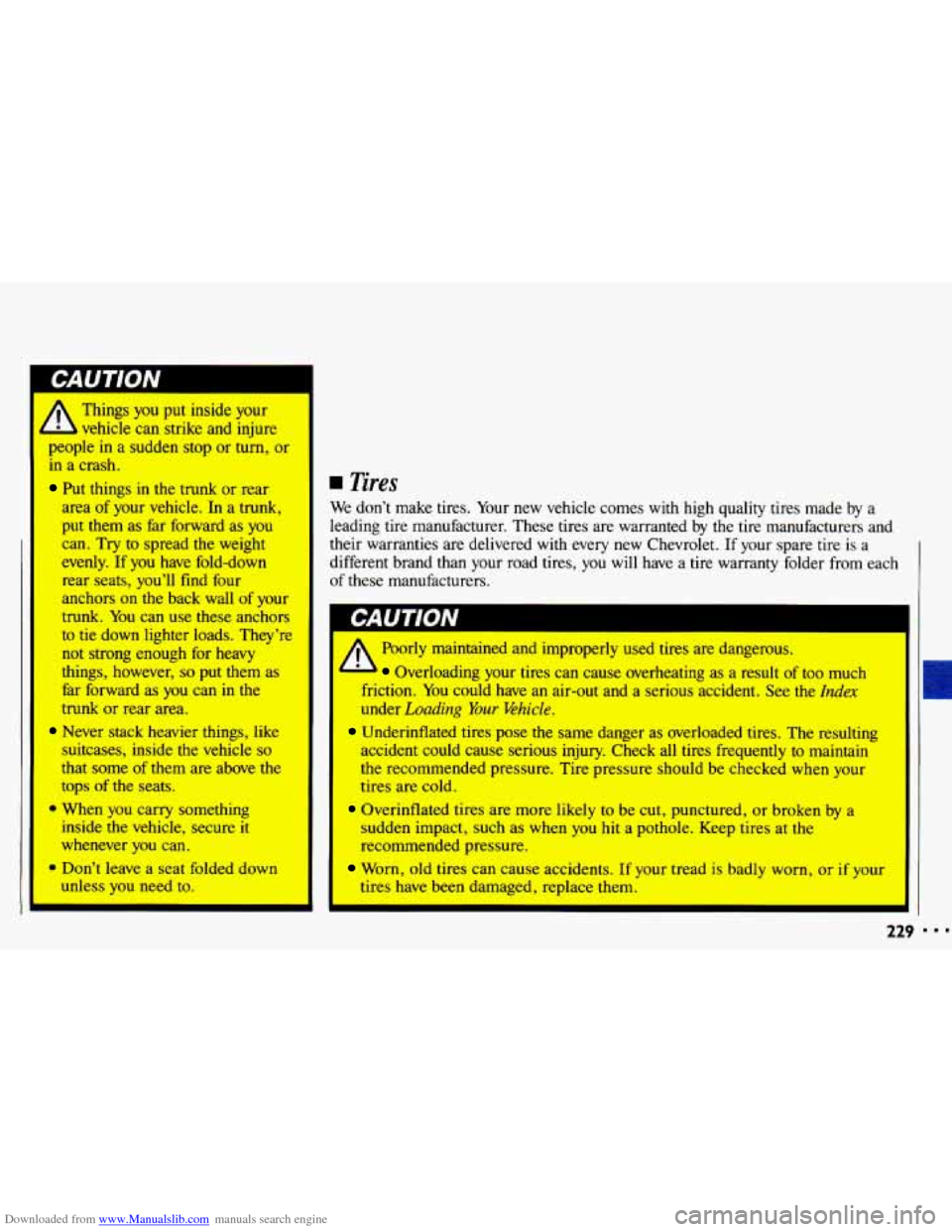
Downloaded from www.Manualslib.com manuals search engine 1--
-
Things you=
strike and injure
people in
a sudden stop or turn, or
in
a crash.
Put things in the trunk or rear
area
of your vehicle. In a trunk,
put them as hr forward as you
can.
Try to spread the weight
evenly.
If you have fold-down
rear seats, you’ll find four
anchors on the back wall
of your
trunk.
You can use these anchors
to tie down lighter loads. They’re
not strong enough for
heavy
things, however, so put them as
fbr forward
as you can in the
trunk or rear area.
Never stack heavier things, like
suitcases, inside the vehicle
so
that some of them are above the
tops
of the seats.
e When you carry something
inside the vehicle, secure it
whenever you can.
unless you need to.
0 Don’t leave a seat folded down
I
Tires
We don’t make tires. Your new vehicle comes with high quality tires made by a
leading tire manufacturer. These tires are warranted by the tire manufacturers and
their warranties are delivered with every
new Chevrolet. If your spare tire is a
different brand than your road tires,
you will have a tire warranty folder from each
of these manufacturers.
I I
CAUTION
Poorly maintained and improperly used tires are dangerous. 1
’ - Overloading your tires can cause overheating as a result of too much
friction. You could have
an air-out and a serious accident. See the Index
under hading Your Vehicle.
Underinflated tires pose the same danger as overloaded tires. The resulting
accident could cause serious injury. Check all tires frequently to maintain
the recommended pressure. Tire pressure should be checked
when your
tires
are cold.
sudden impact:
such as when you hit a pothole. Keep tires at the
recommended pressure.
I Overinflated tires are more likely to be cut, punctured, or broken by a
Worn, old tires can cause accidents. If your tread is badly worn, or if your
I tires have been damaged, replace them. I
229
I
I..
Page 305 of 308
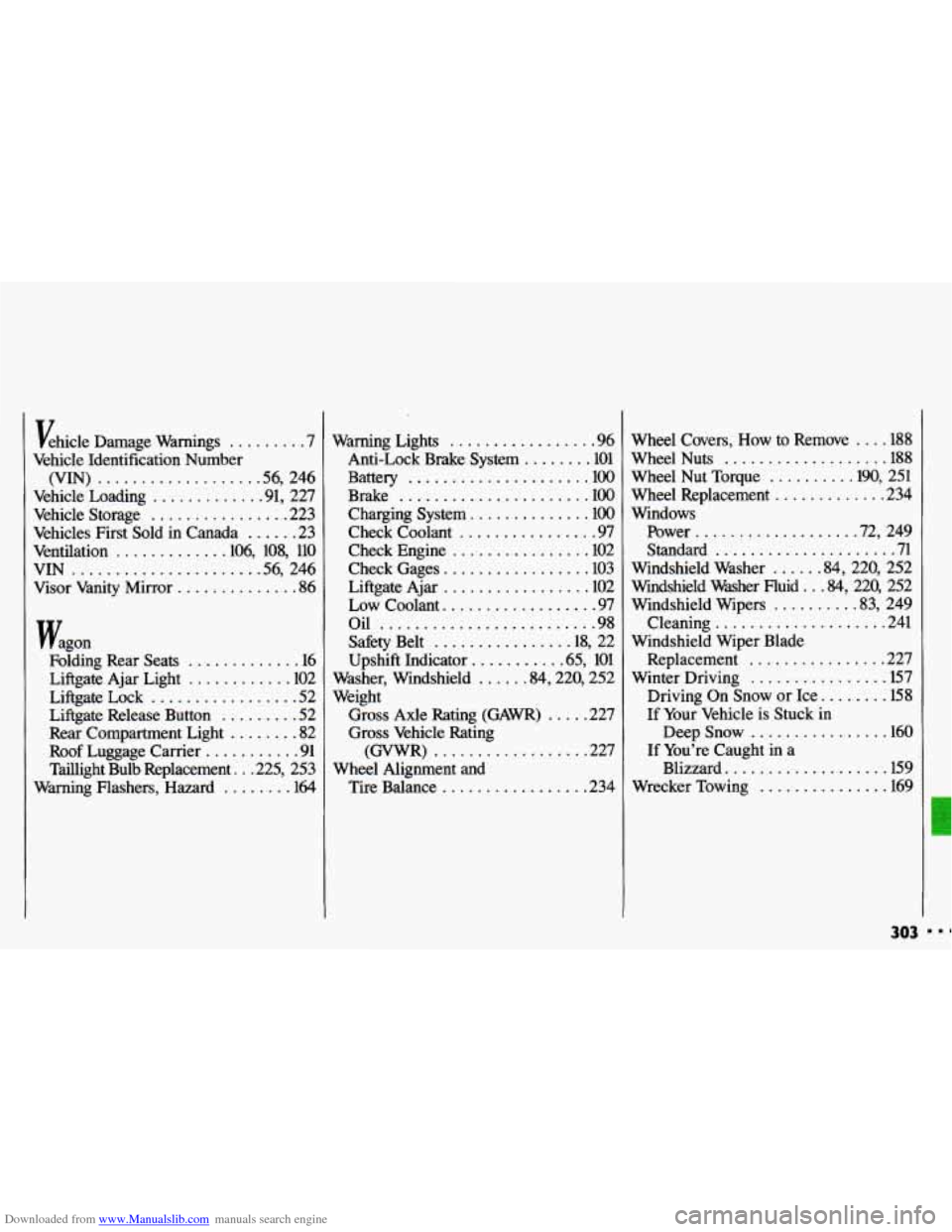
Downloaded from www.Manualslib.com manuals search engine Vehicle Damage Warnings ......... 7
Vehicle Identification Number
Vehicle Loading
............ .91. 227
Vehicle Storage
................ 223
Vehicles First Sold in Canada
...... 23
VIN
...................... 56. 246
Visor Vanity Mirror
.............. 86
(VIN) .................. .56. 246
Ventilation
............ .106. 108. 110
Wagon Folding Rear Seats
............. 16
Liftgate Ajar Light ............ 102
Liftgate
Lock ................. 52
Liftgate Release Button
......... 52
Rear Compartment Light
........ 82
Roof Luggage Carrier
........... 91
Taillight Bulb Replacement
.. .225, 253
Warning Flashers. Hazard
........ 164 Warning Lights
................. 96
Anti-Lock Brake System ........ 101
Battery
..................... lo0
Brake ...................... 100
Charging System .............. lo0
Check Coolant ................ 97
Check Engine
................ 102
Check Gages
................. 103
Liftgate Ajar
................. 102
Low Coolant
.................. 97
Oil ......................... 98
Safety Belt ............... .18, 22
Upshift Indicator
.......... .65, 101
Washer. Windshield
..... .84.220, 252
Weight Gross Axle Rating (GAWR)
..... 227
Gross Vehicle Rating
(GVWR)
.................. 227
Tire Balance
................. 234
Wheel Alignment and Wheel Covers. How to Remove
.... 188
Wheel Nuts
................... 188
Wheel Nut Torque
......... .190. 251
Wheel Replacement
............. 234
Windows Power
.................. .72. 249
Standard
..................... 71
Windshield Washer
..... .84. 220. 252
Windshield Washer Fluid
.. .84. 220. 252
Windshield Wipers
......... .83. 249
Cleaning
.................... 241
Windshield Wiper Blade Replacement
................ 227
Winter Driving
................ 157
Driving
On Snow or Ice ........ 158
If Your Vehicle is Stuck in
Deep Snow
................ 160
If You’re Caught in a
Blizzard
................... 159
Wrecker Towing
............... 169